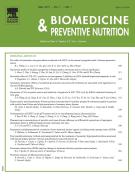Flavonoid rich fraction of Pilea microphylla (L.) attenuates metabolic abnormalities and improves pancreatic function in C57BL/KsJ-db/db mice - 26/11/11

Abstract |
Pilea microphylla Linn. (Urticaceae) and related genera are used in Jamaican and Chinese traditional medicine for the treatment of diabetes. This study was aimed at evaluating the antidiabetic potential of flavonoid rich fraction of Pilea microphylla (PM1) and its possible mechanism of action in C57BL/KsJ-db/db mice. These diabetic mice were treated with PM1 (100mg/kg, i.p.) for 21 days and were evaluated for parameters such as food efficiency ratio, oral glucose tolerance test, inhibition of plasma dipeptidyl peptidase IV (DPP-IV), metabolic markers, pancreas histology and hematological profile. PM1 significantly (P<0.05) reduced body weight, food efficiency ratio, plasma glucose, triglycerides and inhibited plasma DPP-IV, while increasing insulin levels in C57BL/KsJ-db/db mice. PM1 also improved oral glucose tolerance significantly (P<0.05) with mean percentage reduction of 31.2 in glucose excursion (AUC0−120min) and preserved islet architecture of pancreas without showing any detectable hematological toxicity at administered dose. The presence of flavonoids namely quercetin (reported DPP-IV inhibitor), rutin, chlorogenic acid (reported lipid lowering property) along with others (luteolin-7-O-glucoside, apigenin-7-O-glucoside, isorhoifolin) in PM1 reversed the disturbed metabolic milieu in C57BL/KsJ-db/db mice. The overall antidiabetic effect could be the result of the combination of several constituents acting in concert, in a holistic manner, thereby restoring the homeostasis in energy consumption and utilization.
Le texte complet de cet article est disponible en PDF.Keywords : Pilea microphylla Linn., Glucose lowering, β-cell, C57BL/KsJ-db/db, DPP-IV
Abbreviations : PM, PM1, RP-HPLC, w/v, p.o., i.p., FER, OGTT, DPP-IV, PG, TG, TC, CPCSEA, CMC, DPX, ANOVA, MCV, MCH, MCHC, MPV, GSIS
Plan
Vol 1 - N° 4
P. 268-272 - octobre 2011 Retour au numéroBienvenue sur EM-consulte, la référence des professionnels de santé.
L’accès au texte intégral de cet article nécessite un abonnement.
Déjà abonné à cette revue ?

